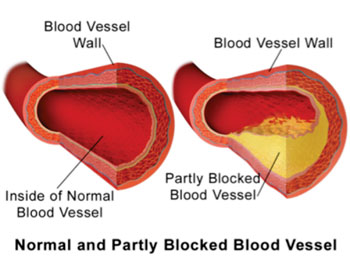Mutation Reducing Fatty Acid-Binding Protein Activity Lowers Heart Attack Risk
|
By LabMedica International staff writers Posted on 08 Sep 2014 |

Image: Illustration comparing a normal blood vessel and partially blocked vessel due to atherosclerotic plaque build-up (Photo courtesy of Wikimedia Commons).
A team of Finnish cardiovascular disease researchers found that a mutation generating a low-expression variant of fatty acid-binding protein 4 (FABP4), reduced the risk of heart attack and stroke.
The FABP4 gene encodes the fatty acid binding protein found in adipocytes. Fatty acid binding proteins are a family of small, highly conserved, cytoplasmic proteins that bind long-chain fatty acids and other hydrophobic ligands. It is thought that the roles of FABPs include fatty acid uptake, transport, and metabolism. Earlier studies detected a mutation (rs77878271) in the human FABP4 gene that caused reduced FABP4 protein transcription.
Investigators at the University of Helsinki (Finland) examined the effects of this low-expression variant of FABP4 on cardiovascular morbidity and carotid atherosclerosis in a random group of 7,491 individuals and in patient cohorts. The cohorts consisted of patients with advanced carotid atherosclerosis who had undergone surgical procedures (endarterectomy) to excise the inner lining of arteries clogged with atherosclerotic buildup (n = 92) and those having experienced myocardial infarction (MI, n = 3,432).
Results published in the August 13, 2014, online edition of the journal Circulation: Cardiovascular Genetics revealed that the low-expression variant was associated with decreased total cholesterol levels with the largest reduction being in individuals carrying two alleles for the variant. Obese variant allele carriers also showed reduced carotid intima-media thickness and lower prevalence of carotid plaques. Consistently, the variant allele homozygotes showed eight-fold lower odds for MI.
The variant allele was associated with a 3.8-fold reduction in FABP4 transcription and 2.7-fold reduction in apoptosis in the macrophages associated with carotid plaques. High FABP4 expression in carotid plaques was associated with lipid accumulation, intraplaque hemorrhages, plaque ulcerations and phosphoactivated ER (endoplasmic reticulum) stress markers.
"It could be that reduced cell stress in the stenosis, attenuated inflammation, as well as reduced accumulation of cholesterol and other lipids in the arteries help keep atherosclerosis asymptomatic among the gene carriers," said first author Dr. Jani Saksi, a researcher in molecular neurology at the University of Helsinki. "These findings suggest that FABP4 could be a new potential target for drug development aiming to prevent lethal and disabling myocardial and cerebral infarctions induced by atherosclerosis. The inhibition of FABP4 activity – especially among obese people in the risk group for atherosclerosis – may prove to be an important method for reducing these individuals' risk for cardiovascular diseases."
Related Links:
University of Helsinki
The FABP4 gene encodes the fatty acid binding protein found in adipocytes. Fatty acid binding proteins are a family of small, highly conserved, cytoplasmic proteins that bind long-chain fatty acids and other hydrophobic ligands. It is thought that the roles of FABPs include fatty acid uptake, transport, and metabolism. Earlier studies detected a mutation (rs77878271) in the human FABP4 gene that caused reduced FABP4 protein transcription.
Investigators at the University of Helsinki (Finland) examined the effects of this low-expression variant of FABP4 on cardiovascular morbidity and carotid atherosclerosis in a random group of 7,491 individuals and in patient cohorts. The cohorts consisted of patients with advanced carotid atherosclerosis who had undergone surgical procedures (endarterectomy) to excise the inner lining of arteries clogged with atherosclerotic buildup (n = 92) and those having experienced myocardial infarction (MI, n = 3,432).
Results published in the August 13, 2014, online edition of the journal Circulation: Cardiovascular Genetics revealed that the low-expression variant was associated with decreased total cholesterol levels with the largest reduction being in individuals carrying two alleles for the variant. Obese variant allele carriers also showed reduced carotid intima-media thickness and lower prevalence of carotid plaques. Consistently, the variant allele homozygotes showed eight-fold lower odds for MI.
The variant allele was associated with a 3.8-fold reduction in FABP4 transcription and 2.7-fold reduction in apoptosis in the macrophages associated with carotid plaques. High FABP4 expression in carotid plaques was associated with lipid accumulation, intraplaque hemorrhages, plaque ulcerations and phosphoactivated ER (endoplasmic reticulum) stress markers.
"It could be that reduced cell stress in the stenosis, attenuated inflammation, as well as reduced accumulation of cholesterol and other lipids in the arteries help keep atherosclerosis asymptomatic among the gene carriers," said first author Dr. Jani Saksi, a researcher in molecular neurology at the University of Helsinki. "These findings suggest that FABP4 could be a new potential target for drug development aiming to prevent lethal and disabling myocardial and cerebral infarctions induced by atherosclerosis. The inhibition of FABP4 activity – especially among obese people in the risk group for atherosclerosis – may prove to be an important method for reducing these individuals' risk for cardiovascular diseases."
Related Links:
University of Helsinki
Latest BioResearch News
- Genome Analysis Predicts Likelihood of Neurodisability in Oxygen-Deprived Newborns
- Gene Panel Predicts Disease Progession for Patients with B-cell Lymphoma
- New Method Simplifies Preparation of Tumor Genomic DNA Libraries
- New Tool Developed for Diagnosis of Chronic HBV Infection
- Panel of Genetic Loci Accurately Predicts Risk of Developing Gout
- Disrupted TGFB Signaling Linked to Increased Cancer-Related Bacteria
- Gene Fusion Protein Proposed as Prostate Cancer Biomarker
- NIV Test to Diagnose and Monitor Vascular Complications in Diabetes
- Semen Exosome MicroRNA Proves Biomarker for Prostate Cancer
- Genetic Loci Link Plasma Lipid Levels to CVD Risk
- Newly Identified Gene Network Aids in Early Diagnosis of Autism Spectrum Disorder
- Link Confirmed between Living in Poverty and Developing Diseases
- Genomic Study Identifies Kidney Disease Loci in Type I Diabetes Patients
- Liquid Biopsy More Effective for Analyzing Tumor Drug Resistance Mutations
- New Liquid Biopsy Assay Reveals Host-Pathogen Interactions
- Method Developed for Enriching Trophoblast Population in Samples
Channels
Clinical Chemistry
view channel
Blood Test Could Predict and Identify Early Relapses in Myeloma Patients
Multiple myeloma is an incurable cancer of the bone marrow, and while many patients now live for more than a decade after diagnosis, a significant proportion relapse much earlier with poor outcomes.... Read more
Compact Raman Imaging System Detects Subtle Tumor Signals
Accurate cancer diagnosis often depends on labor-intensive tissue staining and expert pathological review, which can delay results and limit access to rapid screening. These conventional methods also make... Read moreMolecular Diagnostics
view channel
Multiplex Antibody Assay Could Transform Hepatitis B Immunity Testing
Hepatitis B remains a major global health challenge, yet immunity testing has historically been constrained by cost, operational complexity, and single-analyte approaches. Now, a multiplex antibody assay... Read more
Genetic Testing Improves Comprehensive Risk-Based Screening for Breast Cancer
Breast cancer screening has long relied on age-based guidelines, assuming similar risk across all women despite clear evidence that individual risk varies widely. This one-size-fits-all approach can lead... Read more
Urine Test Could Reveal Real Age and Life Span
Chronological age does not always reflect how quickly the body is aging, as biological age is shaped by genetics, stress, sleep, nutrition, and lifestyle factors such as smoking. A higher biological age... Read more
Genomic Test Identifies African Americans at Risk for Early Prostate Cancer Recurrence
Prostate cancer is one of the most commonly diagnosed cancers in men and a leading cause of cancer-related death, particularly in the United States. African American men face a disproportionately higher... Read moreHematology
view channel
MRD Tests Could Predict Survival in Leukemia Patients
Acute myeloid leukemia is an aggressive blood cancer that disrupts normal blood cell production and often relapses even after intensive treatment. Clinicians currently lack early, reliable markers to predict... Read more
Platelet Activity Blood Test in Middle Age Could Identify Early Alzheimer’s Risk
Early detection of Alzheimer’s disease remains one of the biggest unmet needs in neurology, particularly because the biological changes underlying the disorder begin decades before memory symptoms appear.... Read more
Microvesicles Measurement Could Detect Vascular Injury in Sickle Cell Disease Patients
Assessing disease severity in sickle cell disease (SCD) remains challenging, especially when trying to predict hemolysis, vascular injury, and risk of complications such as vaso-occlusive crises.... Read more
ADLM’s New Coagulation Testing Guidance to Improve Care for Patients on Blood Thinners
Direct oral anticoagulants (DOACs) are one of the most common types of blood thinners. Patients take them to prevent a host of complications that could arise from blood clotting, including stroke, deep... Read moreImmunology
view channel
Ultrasensitive Liquid Biopsy Demonstrates Efficacy in Predicting Immunotherapy Response
Immunotherapy has transformed cancer treatment, but only a small proportion of patients experience lasting benefit, with response rates often remaining between 10% and 20%. Clinicians currently lack reliable... Read more
Blood Test Could Identify Colon Cancer Patients to Benefit from NSAIDs
Colon cancer remains a major cause of cancer-related illness, with many patients facing relapse even after surgery and chemotherapy. Up to 40% of people with stage III disease experience recurrence, highlighting... Read moreMicrobiology
view channel
New UTI Diagnosis Method Delivers Antibiotic Resistance Results 24 Hours Earlier
Urinary tract infections affect around 152 million people every year, making them one of the most common bacterial infections worldwide. In routine medical practice, diagnosis often relies on rapid urine... Read more
Breakthroughs in Microbial Analysis to Enhance Disease Prediction
Microorganisms shape human health, ecosystems, and the planet’s climate, yet identifying them and understanding how they are related remains a major scientific challenge. Even with modern DNA sequencing,... Read morePathology
view channel
Genetics and AI Improve Diagnosis of Aortic Stenosis
Aortic stenosis is a progressive narrowing of the aortic valve that restricts blood flow from the heart and can be fatal if left untreated. There are currently no medical therapies that can prevent or... Read more
AI Tool Simultaneously Identifies Genetic Mutations and Disease Type
Interpreting genetic test results remains a major challenge in modern medicine, particularly for rare and complex diseases. While existing tools can indicate whether a genetic mutation is harmful, they... Read more
Rapid Low-Cost Tests Can Prevent Child Deaths from Contaminated Medicinal Syrups
Medicinal syrups contaminated with toxic chemicals have caused the deaths of hundreds of children worldwide, exposing a critical gap in how these products are tested before reaching patients.... Read more
Tumor Signals in Saliva and Blood Enable Non-Invasive Monitoring of Head and Neck Cancer
Head and neck cancers are among the most aggressive malignancies worldwide, with nearly 900,000 new cases diagnosed each year. Monitoring these cancers for recurrence or relapse typically relies on tissue... Read moreTechnology
view channel
Pioneering Blood Test Detects Lung Cancer Using Infrared Imaging
Detecting cancer early and tracking how it responds to treatment remains a major challenge, particularly when cancer cells are present in extremely low numbers in the bloodstream. Circulating tumor cells... Read more
AI Predicts Colorectal Cancer Survival Using Clinical and Molecular Features
Colorectal cancer is one of the most common and deadly cancers worldwide, and accurately predicting patient survival remains a major clinical challenge. Traditional prognostic tools often rely on either... Read moreIndustry
view channel
BD and Penn Institute Collaborate to Advance Immunotherapy through Flow Cytometry
BD (Becton, Dickinson and Company, Franklin Lakes, NJ, USA) has entered into a strategic collaboration with the Institute for Immunology and Immune Health (I3H, Philadelphia, PA, USA) at the University... Read more



















